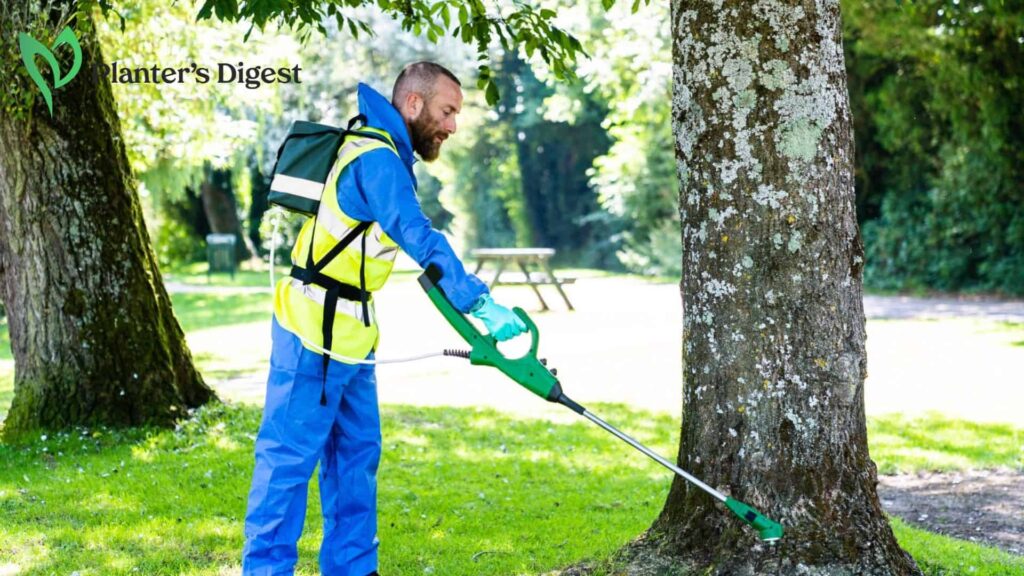
Triclopyr has been all the rage in the gardening community for a while and for good reason.
If you’re curious to see what it’s made of, how to use it, and how else it can be a beneficial addition to your garden maintenance routine, then keep on reading!
Triclopyr Herbicide
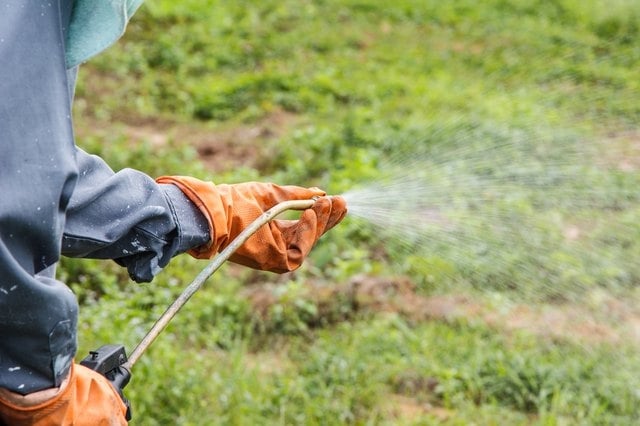
Triclopyr is a fast-acting, man-made systemic herbicide that’s one of the top methods for forestry control in both agricultural and non-agricultural environments.
It’s one of the most sought-after herbicide options in the market because it’s a selective agent. This means that it only targets specific types of plants, namely:
- Broadleaf weeds
- Woody-stemmed plants
- Tree stumps
- Hardy ivies
As a result, you don’t have to worry about nearby plants that don’t fit this classification such as grasses. Hence, it’s commonly used in parklands, grasslands, and forests, among other locations.
Triclopyr herbicides work by mimicking the production of auxin, which is a natural plant growth hormone.
Excessive amounts of auxin absorbed in a short amount of time cause the plant’s cells to loosen and expand uncontrollably.
This inhibits cell division and disrupts a plant’s ability to repair damaged cells and produce new cells, which are required for tissue growth and maintenance.
Over time, this will result in starvation and strangulation. Since triclopyr herbicide is quite strong, it should only take around 2 to 3 weeks for a plant to die after application.
However, in most cases, you can most likely already notice signs of deterioration, such as wilting and yellowing, within the first 24 hours.
Active Ingredients in Triclopyr Herbicide
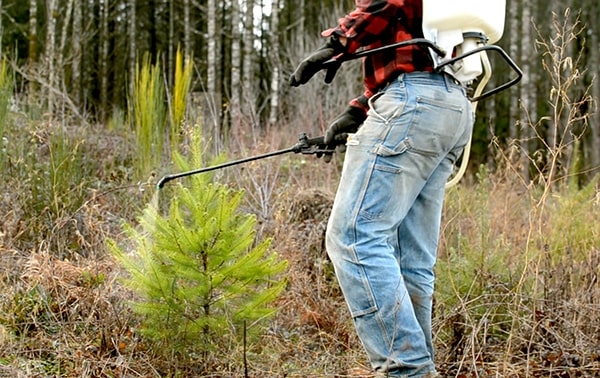
The main active ingredient in triclopyr herbicide is, as the name suggests, triclopyr. This can come in two formulations: amine which is the triethylamine salt (TEA) variation and ester which is the butoxyethyl ester (BEE) variation.
TEA comes in an amine formulation, which makes it more water-soluble. While it’s commercially sold under the name Garlon 3A ®, you’ll find it in garden and hardware stores under the names Turflon Amine ® or as Brush-B-Gone ®.
BEE, on the other hand, is formulated as an ester, which means that it’s more soluble when directly applied on a waxy surface such as a plant’s outer coating.
It goes by the trade name Garlon 4 ®. However, it’s often called Turflon Ester ®, in garden and hardware shops.
It’s important to note that there are instances wherein triclopyr herbicide is mixed with several other agents.
Choosing the right formulation varies on several factors such as
- Time and year of application
- Location and weather conditions
- Plant species
- Application technique
One of the key differences between the two formulations is that amine is more water-soluble. This makes it less effective since it can easily run off a plant’s foliage.
However, this can be easily overlooked if you live in a dry and warm climate that occasionally receives rainfall.
It’s also worth keeping in mind that increased sun exposure and hot weather can actually help increase the volatility of the TEA formulation. This can result in increased effectiveness over the span of just a few hours.
Even then, most gardeners prefer the BEE formulation since it’s lipid soluble. As a result, it coats the plant’s foliage better, making it stick easier.
However, it can take a while for the plant to properly absorb the BEE formulation, which can make some doubt its speed and effectiveness.
Another feature worth noting is that TEA formulations are known to be less volatile than their BEE counterparts.
While this does prove great at handling a large area, the BEE formulations are tricky to work with if you’re only looking to control a specific scope of your property. Otherwise, you can risk damaging nearby plants.
Having mentioned that, BEE formulations are known to be highly poisonous to sea life such as fish and aquatic invertebrates. Hence, it’s vital that they’re not used near bodies of water.
All said, you may still want to experiment with the different formulations to see which works best for you.
Here’s a quick summary of what we’ve covered so far on both the TEA and BEE triclopyr herbicide formulations:
| TEA | BEE | |
| Formulation | Triethylamine salt | Butoxyethyl ester |
| Trade Name | Garlon 3A ® | Garlon 4 ® |
| Commercial Name | Turflon Amine ®Brush-B-Gone ® | Turflon Ester ® |
| Volatility | Average | High |
| Solubility | Water soluble | Lipid soluble |
Uses of Triclopyr Herbicide
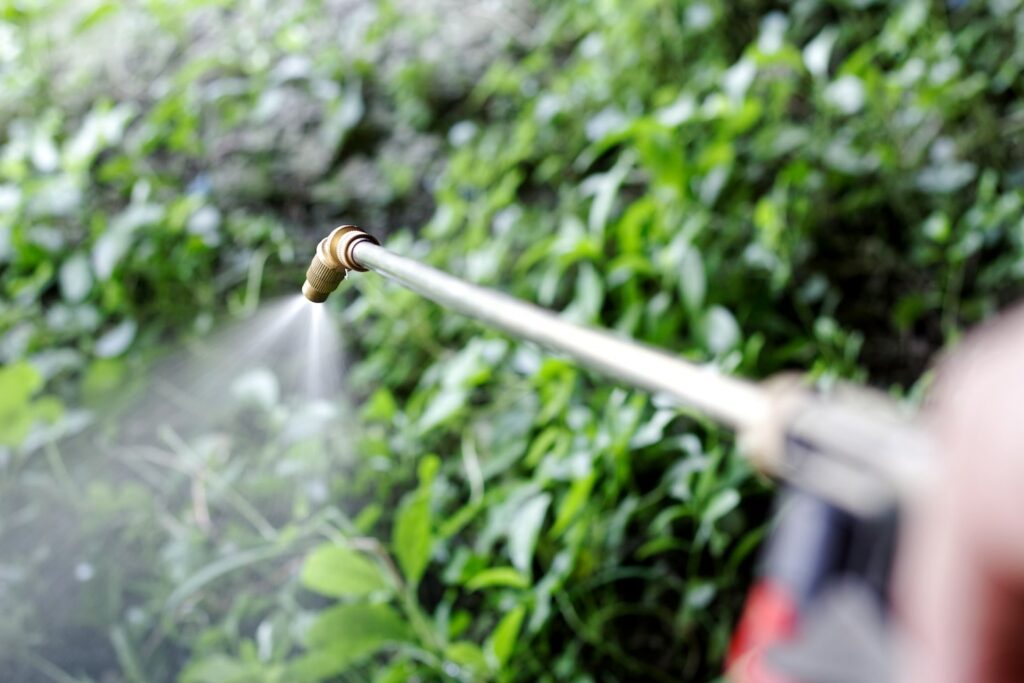
Triclopyr herbicide is incredibly effective at tackling the following types of plants:
- Broadleaf weeds
- Woody-stemmed plants
- Tree stumps
- Hardy ivies
Hence, it’s widely used in a variety of agricultural and non-agricultural settings such as forest plantations, crop fields, and forests, among others.
According to the Weed Control Methods Handbook, triclopyr herbicide is a popular method of controlling the following plants in America:
- Tree of heaven (Ailanthus altissima)
- Salt cedar (Tamarix spp.)
- Glossy buckthorn (Frangula alnus)
- Common buckthorn (Rhamnus cathartica)
- Sweet fennel (Foeniculum vulgare)
- Brazilian peppertree (Schinus terebinthifolius)
- Chinese tallow tree (Sapium sebiferum)
Meanwhile, it’s well known to be successful at controlling the following plants in Hawaii:
- Blackwood acacia (Acacia melanoxylon)
- Bush honeysuckle (Lonicera maackii)
- Chinese banyan (Ficus microcarpa)
- Corkystem passionflower (Passiflora suberosa)
- Eucalyptus (Eucalyptus globulus)
- Florida prickly blackberry (Rubus argutus)
- Mexican weeping pine (Pinus patula),
- Monterey pine (Pinus radiata)
- Strawberry guava (Psidium cattleianum)
- Tropical ash (Fraxinus uhdei)
- Velvet leaf (Miconia calvescens)
Application Guidelines for Triclopyr Herbicide
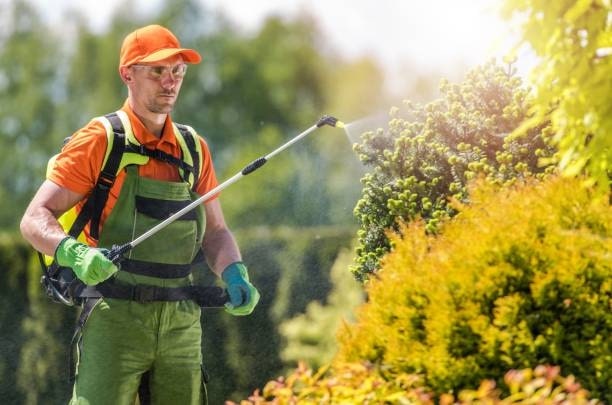
Triclopyr herbicide application can be done via several ways. These include:
- Spraying on the leaves
- Smearing onto the tree bark
- Injecting into the tree
- Pouring onto the surrounding soil
Even then, be sure to carefully read through the instructions and apply the triclopyr herbicide exactly as instructed.
1. Foliar Application
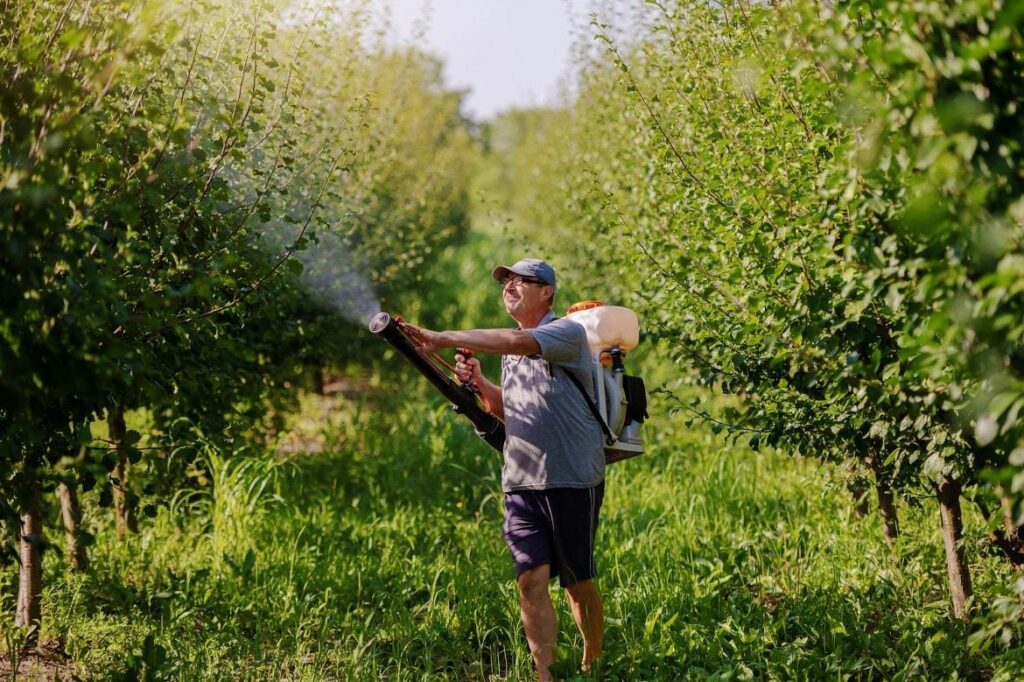
Foliar application involves spraying the triclopyr herbicide directly onto the leaves of the plant.
Depending on the formulation, you may need to dilute the herbicide with water to ensure that it will be distributed evenly with a spray.
This method is best used when the plants you’re targeting are tall and have dense foliage.
2. Basal Application
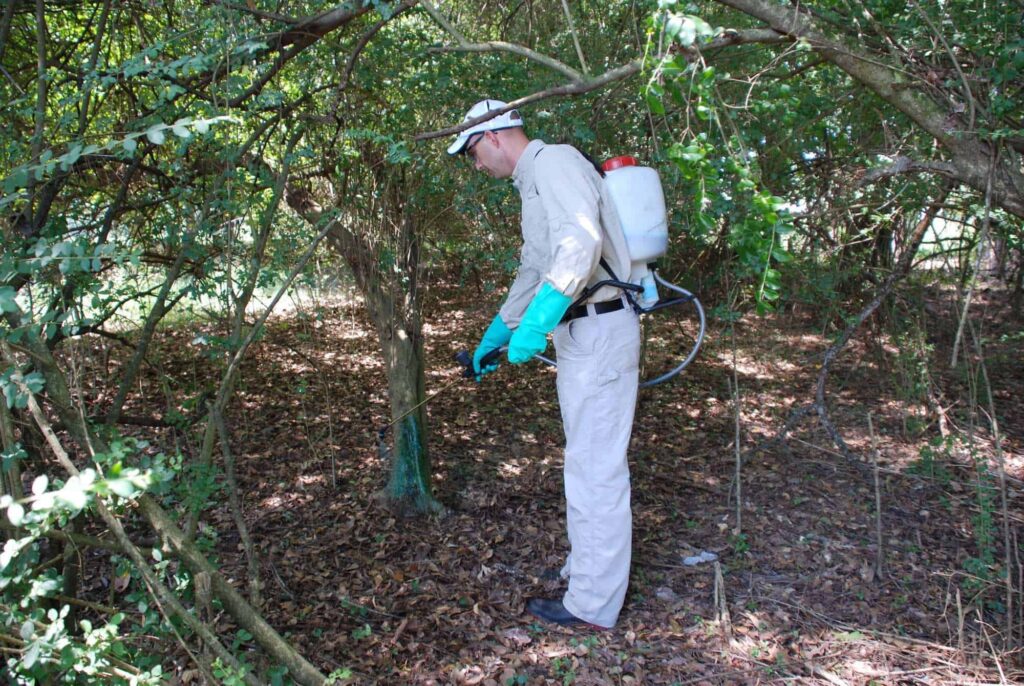
Basal application involves mixing the triclopyr herbicide with an oil penetrant. Afterward, it’s directly smeared onto the bottom half of the tree bark.
Triclopyr herbicide should be generously applied about 12 to 18 inches from the base of the tree.
It’s important to highlight that basal application is most effective on younger trees and those with a diameter of below 6 inches.
Otherwise, the herbicide won’t be as volatile. In this case, reapplication may not even be worth trying as other methods may yield more promising results.
3. Hack-and-Squirt Technique
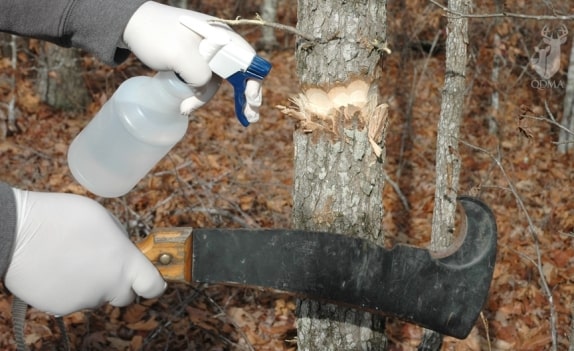
Image: National Deer Association
The hack-and-squirt technique is just as it sounds – it entails creating a deep, downward slice through the bark of the tree at a 45-degree angle and then applying triclopyr herbicide onto the gash.
For this method, it’s important that the cut is able to hold in the herbicide solution. Otherwise, it’ll simply leak out.
Alternatively, you can simply cut a tree to a stump and apply the triclopyr herbicide directly onto the entire surface – around the top and collar of the stump.
Keep in mind that to yield the best results, the herbicide solution must be applied on a freshly cut stump.
Safety Precautions When Using Triclopyr Herbicide
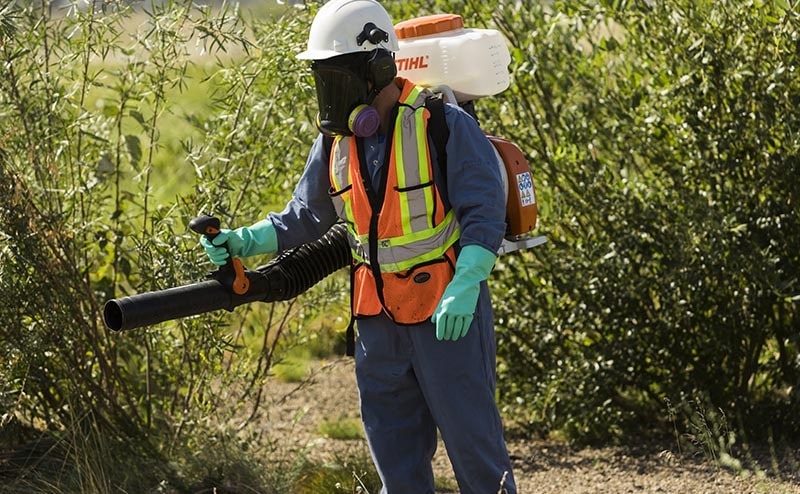
Like other chemical herbicides, triclopyr is highly toxic and can cause several health issues when exposed to it, either from contact or simply breathing in.
In fact, direct contact with the TEA or salt variety of triclopyr herbicide can cause eye irritation and even lead to permanent impairments.
While triclopyr herbicide has shown low levels of toxicity when inhaled, it can still cause several issues. This includes lethargy, breathing difficulties, and teary eyes, among others.
While accidents can happen, it’s important to place preventive measures to avoid any mishaps.
To help you create a full-proof safety plan, here are a couple of tips you can follow:
- Read the prescribed application and first aid instructions on the package carefully and intentionally.
It’s a common practice when reading instructions that the words often fly over our heads as we already have a hunch of what the directions will say.
However, when dealing with toxic chemicals, it’s important to place more caution when learning how to apply them.
- Wear personal protective equipment to minimize exposure. Here’s a list of protective gear that you can put on:
- Goggles or safety glasses
- Full-face respirator
- Face shield
- Rubber gloves
- Long-sleeved clothing that covers any exposed skin
- Practice careful application. Double-check what the weather will be like the day you plan to use triclopyr herbicide.
As much as possible, avoid use on windy and rainy days to prevent splashes.
- Close off the treated area for a couple of weeks to ensure that it isn’t easily accessible by children and pets.
- Have the contact information of your local poison control and emergency services on hand.
In the event of an emergency, you’d want to easily and quickly be able to reach out to them to get the medical assistance necessary.
Benefits of Using Triclopyr Herbicide

The biggest benefit of using triclopyr herbicide is that you don’t have to worry about severely harming nearby plants and crops, since it’s a selective agent.
Hence, it’s a popular control method for railways, forestry, rangeland, industrial areas, parkways, and plantation crops, to name a few.
Aside from that, it works fairly quickly compared to other herbicide alternatives. This saves you a lot of time and effort on other time-consuming and strenuous options.
In fact, you’ll be able to notice results as fast as the first 24 hours. It’ll only take about 2 to 3 weeks for the plant to completely die.
Potential Risks and Side Effects of Using Triclopyr Herbicide
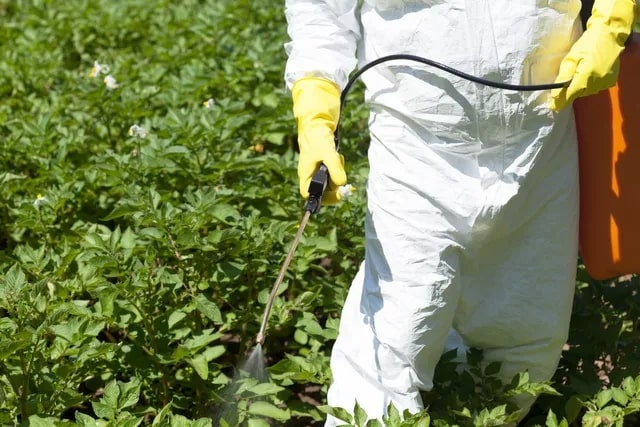
It’s unfortunate to say that while triclopyr herbicide works wonders, it also brings about certain risks.
First of all, it’s an incredibly potent product. Hence, following the prescribed dosage and application instructions are crucial so as not to overdo it.
Aside from that, it’s toxic to both humans and animals. In humans, exposure, especially to the eyes, can cause severe irritation and potentially long-term damage.
In animals, the ester formulation of triclopyr herbicide is most known to affect fish, algae, and aquatic invertebrates. Meanwhile, the TEA form is almost completely non-toxic.
When it comes to common garden insects, triclopyr herbicide isn’t toxic to bees. However, data and long-term studies are admittedly lacking.
Triclopyr herbicide can affect vegetation which, in turn, can negatively affect the number of butterflies, bees, beetles, spiders, and other beneficial insects on your property.
Alternatives to Triclopyr Herbicide
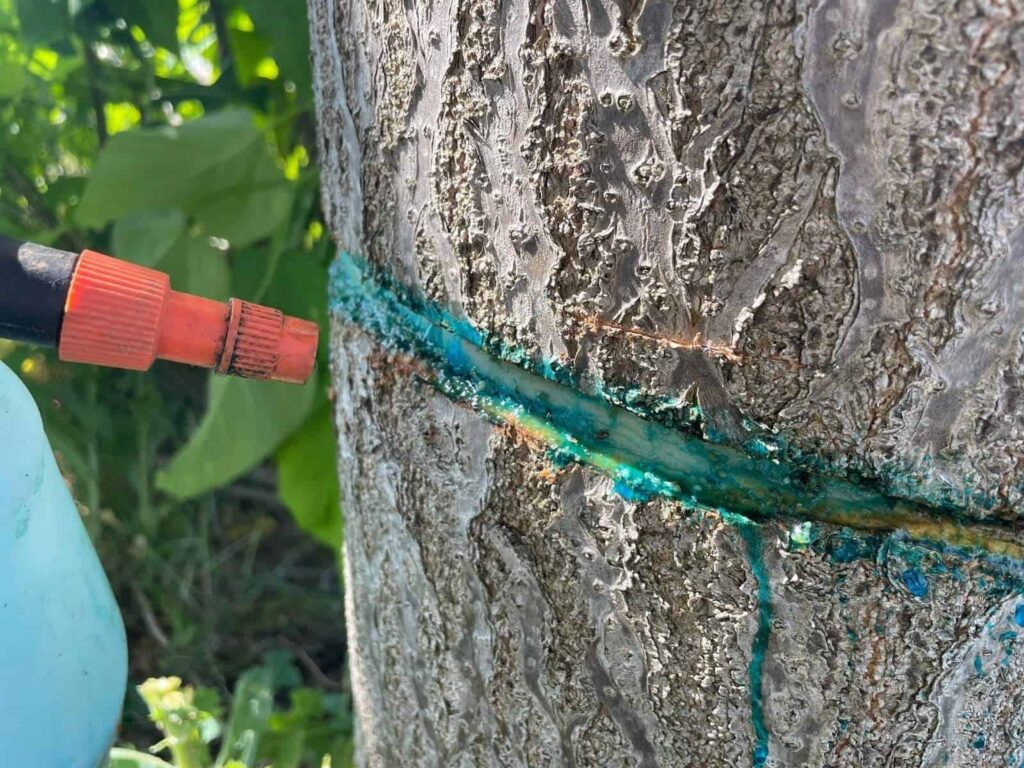
Even though triclopyr herbicide is one of the world’s leading control solutions, it may not be for everybody. So if you’re looking for alternatives, here are a couple of other effective ways to control unwanted plants on your property:
1. Glyphosate
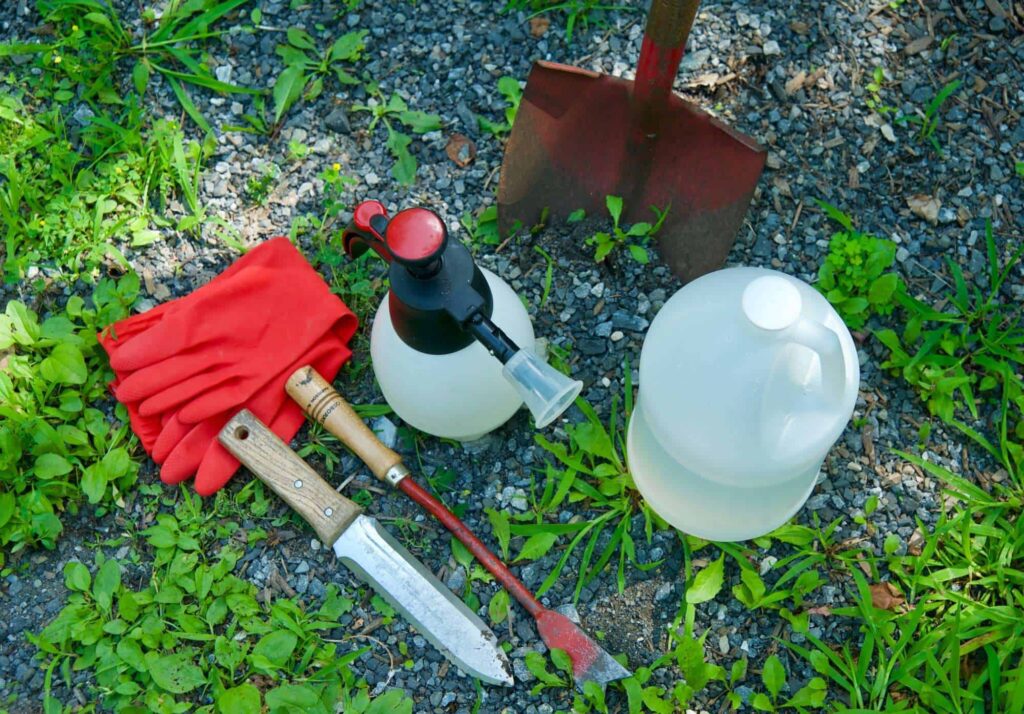
Glyphosate is another well-known and commonly used herbicide to control unwanted plants. While it’s not typically used alone, it’s a popular ingredient in many herbicide mixes.
Similar to triclopyr herbicide, it works by inhibiting plant cell division, completely stopping protein production. It also damages all parts of the plants, from roots to leaves.
The main difference is that triclopyr is a selective herbicide while glyphosate isn’t. In other words, triclopyr only works on specific types of plants while glyphosate will harm any plant it comes into contact with.
As a result, it isn’t entirely environmentally-friendly as run-offs can harm nearby plant life. Aside from that, exposure has been known to cause several disorders and defects.
On the bright side, glyphosate is available in various strengths, formulations, and concentrations. This aids gardeners in picking out variants for specific applications and needs.
2. Horticultural Vinegar
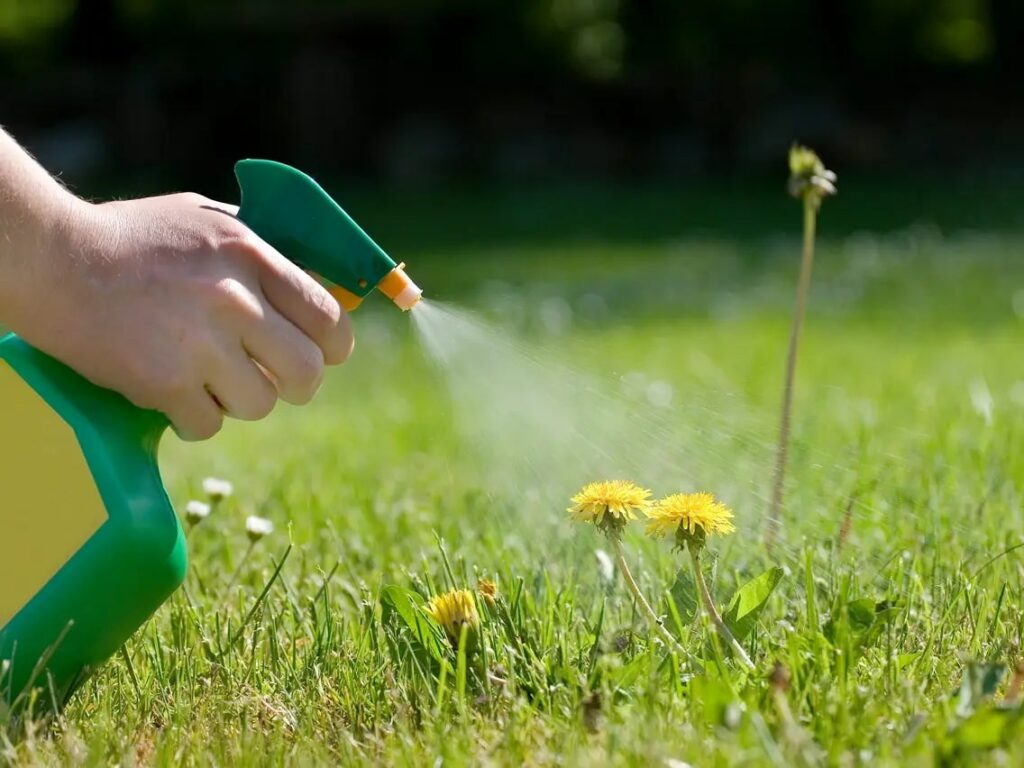
Horticultural is a popular organic method for eradicating unwanted plants because it only requires 1 ingredient.
All vinegar varieties contain acetic acid at varying levels of concentration. This determines its strength and what it can be used for.
Your typical household vinegar, distilled white vinegar, contains only about 5%. It’s typically used for cooking but is powerful enough for cleaning and preserving food.
Meanwhile, horticultural vinegar is about 4 times stronger than household vinegar. It contains 20% acetic acid.
As a result, it’s great at burning through virtually any plant that it comes into contact with. For greater effectivity, it should be applied on hot days when you can expect the most amount of sunlight.
Having said that, it’s important to be careful when using it to avoid any damage to yourself and nearby plants.
3. Herbicidal Soaps
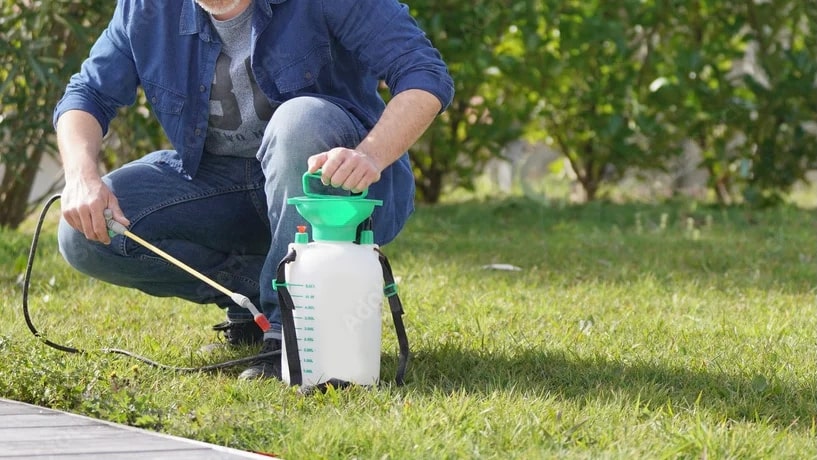
Herbicidal soaps are fast-acting control methods that can kill plants within just a few hours. They work by promoting fatty acids in plants, causing cells to die.
They’re typically sold at various concentrations. Even then, herbicidal soaps are incredibly potent which is why it’s important that the prescribed instructions are followed as directed.
More often than not, herbicidal soaps need to be diluted in water. Then, you can apply as instructed onto the foliage.
Keep in mind that herbicidal soaps are non-selective, which means that they’ll damage any plant they’re applied on. Hence, you’ll want to avoid applications on windy and rainy days to avoid run-offs.
4. Manual Removal
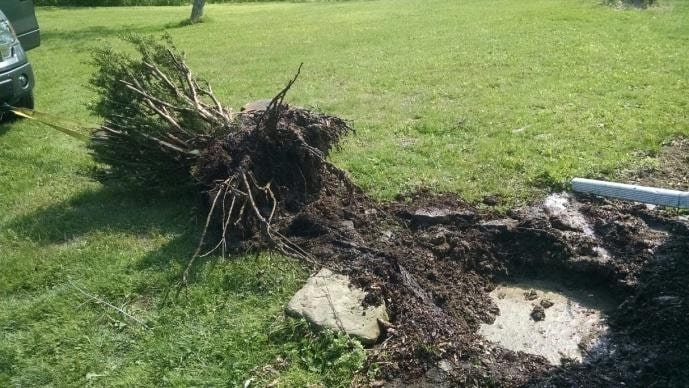
Manual removal is one of the safest ways to ensure that you’re not polluting the environment with chemicals, changing the pH levels, and similar disruptive behavior.
As straightforward as it sounds, it entails removing unwanted plants by hand and with the help of hand-held devices.
Unfortunately, it’s one of the most labor-intensive and impractical methods. Even then, this is a rather small price to pay for a technique that is herbicide-free.
Storage and Disposal of Triclopyr Herbicide
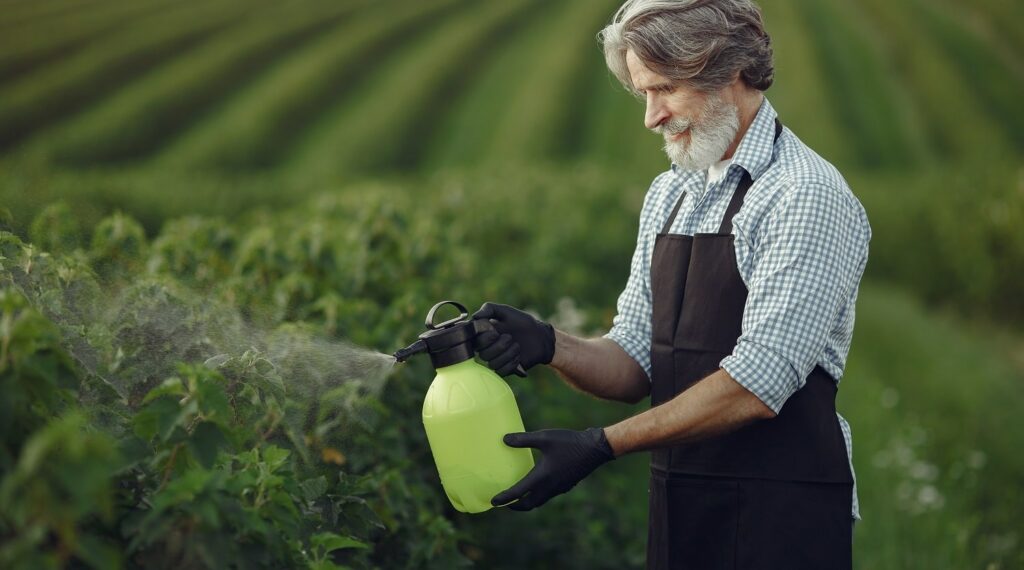
You can store your triclopyr herbicide just like any other herbicide in your collection. Simply keep it in a cool, dry, well-ventilated place that has a temperature of above 28°F.
Aside from that, ensure that your storage facility is constantly locked. This guarantees that it isn’t easily accessible by others, especially children.
As for disposal, avoid discarding your triclopyr herbicide in your garbage bins. Rough handling can cause it to leak, risking exposure to unsuspecting individuals and the environment.
Instead, surrender it to an approved waste management facility or your local household hazardous waste service. You can get in touch with your district for any regional collection centers.
FAQs
Triclopyr herbicide is primarily used to kill broadleaf weeds, poison ivy, and woody plants. It’s a selective herbicide, which means that it won’t harm grasses and other plants that don’t fit the classification above.
Its main function is to inhibit cell division from the plant’s leaves, resulting in starvation and strangulation.
Meanwhile, glyphosate is a non-selective herbicide, which means that it’ll kill any plant species that it’s applied on.
Glyphosate works by hindering plant cell division, completely stopping protein production. It also damages all parts of the plants, from roots to leaves.
Triclopyr herbicide stays in the soil for anywhere from 30 to 90 days depending on the environmental conditions.
Even with tests done, triclopyr herbicide isn’t known to be cancerous, but more studies are needed to be able to obtain a more definite answer.
However, it is toxic and can cause irritation on the skin and eyes. Hence, it’s highly recommended to wear personal protective equipment and to follow application instructions carefully as prescribed to avoid any accidents.
Since triclopyr herbicide is a fast-acting agent, it only takes around 2 to 3 weeks after application for a plant to completely die.
In most cases, you’ll already be able to notice signs of deterioration, such as wilting and yellowing, within the first 24 hours.
For faster results, leave the plant undisturbed for 1 week to fully absorb the herbicide.




